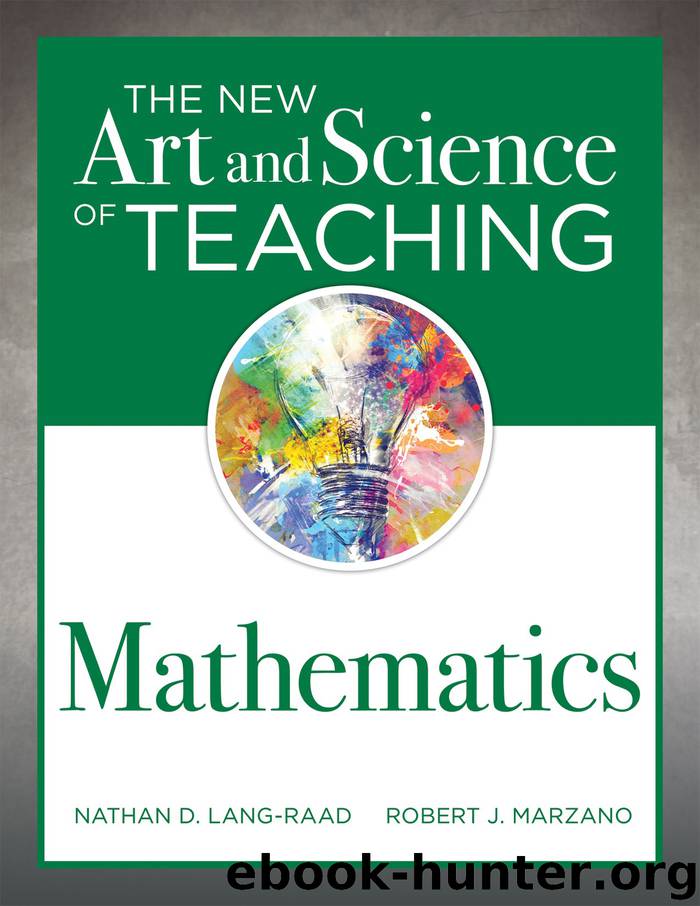The New Art and Science of Teaching Mathematics by Nathan D. Lang-Raad

Author:Nathan D. Lang-Raad
Language: eng
Format: epub
Publisher: Solution Tree Press
Published: 2019-05-16T04:00:00+00:00
Figure 6.14: Framed focus questions.
5. After sharing the dilemma with the small group, the presenter ends the description by asking a specific and thoughtful question, “What do you really want to know? What is your real dilemma?” The dilemma is the problem group members face when tackling the question. There are some things that are known, so that information shouldn’t be in the question (such as information specifically given in the scenario). This question will help the student group focus its feedback. Yes-or-no questions generally provide less feedback, so they should be avoided. With this step, presenters have the opportunity to tap into the thoughts of the group.
6. The group members then talk with each other about the dilemma. In this step, the group works to define the issues more thoroughly and objectively. Sometimes members of the group suggest actions the presenter might consider taking; if they do, they should frame them as suggestions made only after the group has thoroughly analyzed the dilemma. The presenter doesn’t speak during this discussion, but listens and takes notes. This step should take about fifteen minutes.
Possible questions to spark conversation within the discussion include:
• What did we hear?
• What didn’t we hear that might be relevant?
• What assumptions seem to be operating?
• What questions does the dilemma raise for us?
• What do we think about the dilemma?
• What might we do or try if faced with a similar dilemma?
• What have we done in similar situations?
7. The student presenter then reflects on what she or he heard and on what he or she is now thinking, sharing with the group anything that particularly resonated for him or her during any part of the group work. This step should take about five minutes.
8. The teacher then leads a brief conversation about the group’s observation of the consultancy process. This step should take about five minutes.
Elaboration is an inferential act that fosters new awareness when students engage in it effectively. Figure 6.15 depicts the self-reflection scale for this element.
Download
This site does not store any files on its server. We only index and link to content provided by other sites. Please contact the content providers to delete copyright contents if any and email us, we'll remove relevant links or contents immediately.
| Arts & Humanities | Health |
| Language Arts | Library Skills |
| Mathematics | Reading & Phonics |
| Science & Technology | Social Studies |
The Art of Coaching Workbook by Elena Aguilar(50063)
Trainspotting by Irvine Welsh(20974)
Twilight of the Idols With the Antichrist and Ecce Homo by Friedrich Nietzsche(18279)
Fangirl by Rainbow Rowell(8771)
Periodization Training for Sports by Tudor Bompa(7895)
Change Your Questions, Change Your Life by Marilee Adams(7335)
This Is How You Lose Her by Junot Diaz(6411)
Asking the Right Questions: A Guide to Critical Thinking by M. Neil Browne & Stuart M. Keeley(5333)
Grit by Angela Duckworth(5275)
Red Sparrow by Jason Matthews(5175)
Paper Towns by Green John(4769)
Room 212 by Kate Stewart(4716)
Ken Follett - World without end by Ken Follett(4424)
The Sports Rules Book by Human Kinetics(4057)
Housekeeping by Marilynne Robinson(4039)
Double Down (Diary of a Wimpy Kid Book 11) by Jeff Kinney(3893)
Papillon (English) by Henri Charrière(3885)
Exercise Technique Manual for Resistance Training by National Strength & Conditioning Association(3765)
The Motorcycle Diaries by Ernesto Che Guevara(3763)
